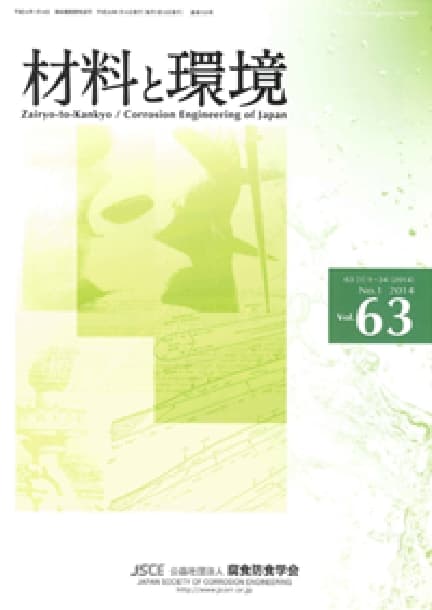- TOP
- Zairyo-to-Kankyo
- Vol. 65 (2016), No. 2
Zairyo-to-Kankyo Vol. 65 (2016), No. 2
Backnumber
-
Vol. 74 (2025)
-
Vol. 73 (2024)
-
Vol. 72 (2023)
-
Vol. 71 (2022)
-
Vol. 70 (2021)
-
Vol. 69 (2020)
-
Vol. 68 (2019)
-
Vol. 67 (2018)
-
Vol. 66 (2017)
-
Vol. 65 (2016)
-
Vol. 64 (2015)
-
Vol. 63 (2014)
-
Vol. 62 (2013)
-
Vol. 61 (2012)
-
Vol. 60 (2011)
-
Vol. 59 (2010)
-
Vol. 58 (2009)
-
Vol. 57 (2008)
-
Vol. 56 (2007)
-
Vol. 55 (2006)
-
Vol. 54 (2005)
-
Vol. 53 (2004)
-
Vol. 52 (2003)
-
Vol. 51 (2002)
-
Vol. 50 (2001)
-
Vol. 49 (2000)
-
Vol. 48 (1999)
-
Vol. 47 (1998)
-
Vol. 46 (1997)
-
Vol. 45 (1996)
-
Vol. 44 (1995)
-
Vol. 43 (1994)
-
Vol. 42 (1993)
-
Vol. 41 (1992)
-
Vol. 40 (1991)
Keyword Ranking
16 Dec. (Last 30 Days)
Zairyo-to-Kankyo Vol. 65 (2016), No. 2
Preferential Dissolution Mechanism of α or γ phase in Crevice Corrosion of Duplex Stainless Steels
So Aoki
pp. 45-50
DOI:
10.3323/jcorr.65.45Abstract
Duplex stainless steels (DSS) possess a ferritic (α) phase matrix dispersed with austenitic (γ) phase precipitates. Due to the chemical compositional arrangement and the characteristic α/γ dual phase structure, DSS possess superior mechanical properties and corrosion resistance without sacrificing economic performance. In any case, even DSS suffer from crevice corrosion. Accordingly, the measure of crevice corrosion is of pragmatic importance. The modes of crevice corrosion on DSS were complex because of its preferential dissolution and distinguishable as some types from the outside to the center of the crevice: the passivity retention region, the region with preferential dissolutions of γ phase precipitates, and the region with preferential dissolution of the α phase matrix. It is described the study to elucidate the preferential dissolution mechanism of crevice corrosion on DSS, based on the in-situ observation of crevice corrosion dissolution behavior, and the analysis of dissolution behavior of DSS, α and γ phases in a simulated crevice solution.
Study on Corrosion Environment of the Copper Parts by Condensate Liquid of Diesel Engine Combustion Gasses
Yo Hosaka, Etsuko Goto, Hiroshi Uchigata, Yuji Fujikawa, Hiroshi Kataoka, Takashi Nagayoshi, Tsuyoshi Tateishi
pp. 59-66
DOI:
10.3323/jcorr.65.59Abstract
A copper part (C1100), used in an EGR-equipped engine, got corroded. This copper part was directly contacting an iron part (S45C), for which the iron part should have been corroded before the copper one began being corroded, because iron is less noble than copper. However, it was found that the corrosion had taken place only on the copper part.
In order to clarify the reason, we investigated the phenomenon for substances related to the corrosion and tried to identify how the environments became corrosive and what mechanisms caused the corrosion, using a chemical method.
As the result, we came up with the conclusion that a solution consisting of sulfuric acid and nitric acid might probably have worked on the corrosion, by verifying that copper becomes more corrosive than iron in a place where nitric acid is present.
Solution pH and Specific Solution Volume to Specimen Surface Area on Corrosion Reactions and Hydrogen Absorption of Steel in Solutions Containing Thiocyanate Ion.
Mikiyuki Ichiba, Kenichi Takai, Jun'ichi Sakai
pp. 67-74
DOI:
10.3323/jcorr.65.67Abstract
An ammonium thiocyanate (NH4SCN) solution is widely used in hydrogen embrittlement evaluations of high-strength steel materials. It is known that an increase in the specific solution volume to the specimen surface area results in a severe evaluation in hydrogen embrittlement testing. The reason for that is explained in this paper based on the change in the solution pH induced by a cathodic reaction, which accompanies thiocyanate ion decomposition and governs hydrogen absorption. In addition, the pH dependence of the cathodic reaction governing hydrogen absorption is made clear by using a sodium thiocyanate solution containing a buffer solution to control the solution pH. It is shown that immersing steel specimens in the pH-controlled sodium thiocyanate solution achieves a higher hydrogen content compared with the level attained with the NH4SCN solution.
Article Access Ranking
16 Dec. (Last 30 Days)
-
Delayed Fracture Mechanism of 1700 MPa-Class Quenched and Tempered Bolt under Atmospheric Corrosion Environment
Tetsu-to-Hagané Advance Publication
-
Perspectives on the Promising Pathways to Zero Carbon Emissions in the Steel Industry toward 2050
ISIJ International Vol.65(2025), No.2
-
Effect of B on Surface Oxidation Behavior and Phosphatability of Si-Mn-added Cold-Rolled Steel Sheets
ISIJ International Advance Publication
-
Factors Influencing the Bonding Phase Structure of Iron Ore Sinters
ISIJ International Vol.43(2003), No.9
-
Effect of microstructural heterogeneity on fatigue limit of as-quenched low-carbon low-alloy martensitic steel
ISIJ International Advance Publication
-
Prussian blue as a fully reversible hydrogenochromic material for visualizing hydrogen distribution in Fe sheet
ISIJ International Advance Publication
-
Progress of Strip Casting Technology for Steel; Historical Developments
ISIJ International Vol.52(2012), No.12
-
-
Microstructures and Reduction Properties of High CaO Concentration Sintered Ore
ISIJ International Advance Publication
-
Influence of Antimony on the Oxidation Characteristics of 65Mn Steel
ISIJ International Advance Publication
You can use this feature after you logged into the site.
Please click the button below.










